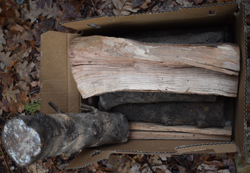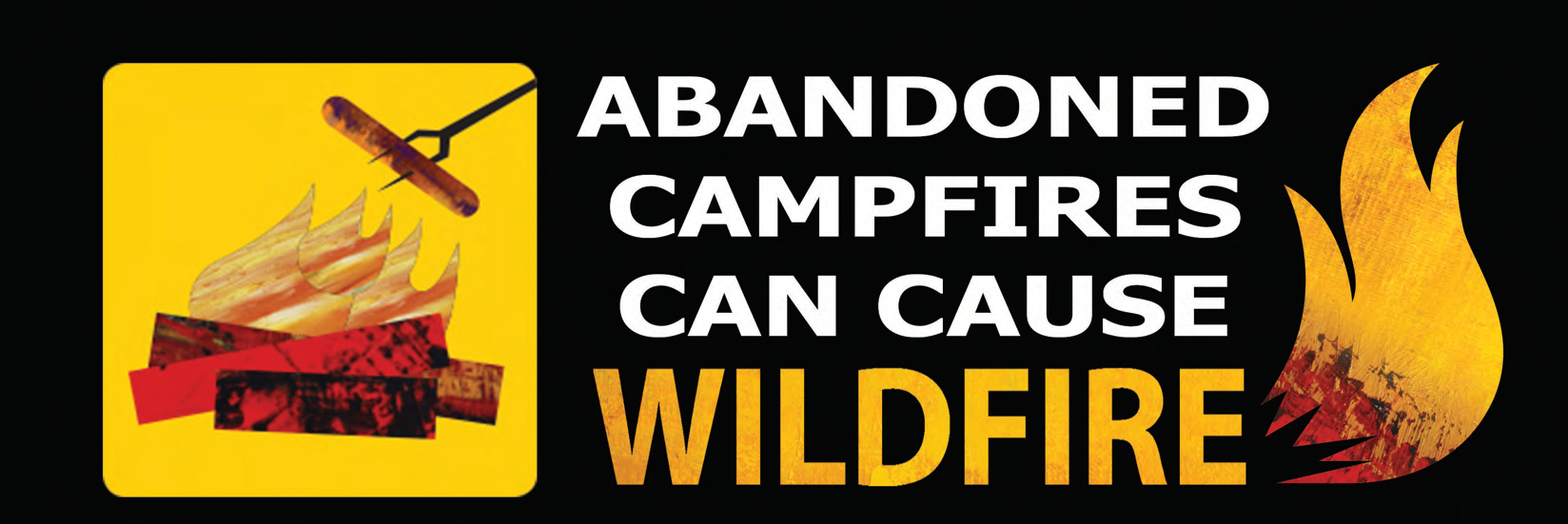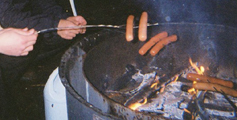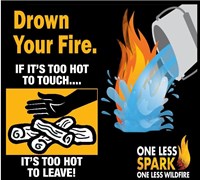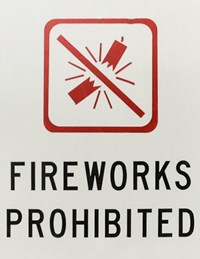This page includes
how to build a campfire that doesn’t smoke a lot
and how to put out a campfire thoroughly,
without annoying the neighbors (according to rules for Yosemite National Park, and many other jurisdictions).
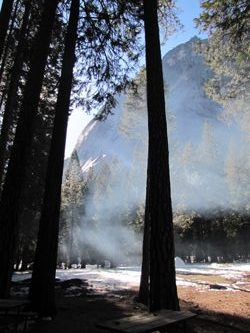
Smoking campfires cause a lot of pollution and can get your next door campsite neighbors (or even neighbors many yards away) coughing.
It is easy to build a campfire that doesn’t smoke much.
(FIREWOOD for our Yosemite trips and many other areas): As long as Sudden Oak Death is still a problem, we must follow quarantines of host material, including local (Santa Clara County and other infected coastal counties) firewood. We can’t even bring cut up scrap lumber or pallets. We need to buy it in the park, or bring Presto type “logs” (compressed sawdust and wax) or “Firewood collection of dead and down wood is permitted within the boundaries of campgrounds in Yosemite Valley, and can otherwise be gathered anywhere in the park that is outside Yosemite Valley, below 9,600 feet, and not in a sequoia grove.” But the dead and downed wood that is actually burnable available on the ground in campgrounds is rare, so plan ahead to bring presto-type logs or buy bundles / boxes of wood in the park.)

Yes, you can spend time whittling pieces of wood into fancy tinder pieces, but I have other ideas for spending time on vacation). You need to split some of it with a hatchet, which is safer during daylight hours
Green sticks off the ground won’t burn well or at all. If you choose to use wood you find where you are camping, (and if it is allowed)
use only dead and down wood. Don’t break branches from a tree even if it looks dead.
Almost everywhere you might camp will give you a copy of the rules when you arrive. They can be quite different than the last place you camped. In some places it is actually against the law to bring in wood from other locations. Sometimes there are more restrictions than the last time you camped at the same place because of dry conditions.
Small sections of not too-tightly-crumpled newspaper start a fire much more easily than pine needles and smoke a lot less.

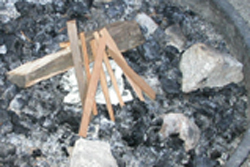
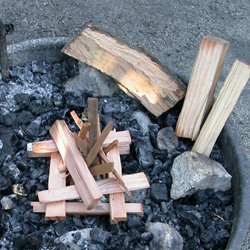


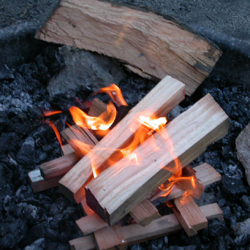
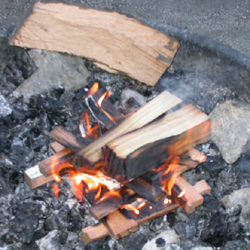
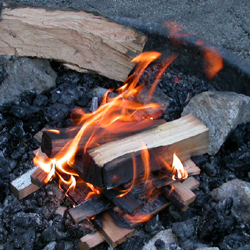
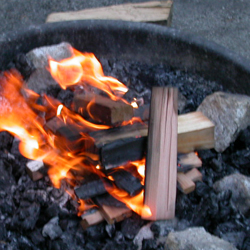
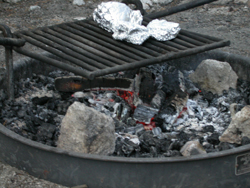
Boxes of firewood you can buy in parks will likely have various sizes of wood pieces. Look for “kindling included” on the box. The branch / log shaped piece in the bottom left corner of this box, not split down the center, should be the last piece you put on, once you have the fire going well enough that it will light.
As a reminder, simply pouring water on a fire is not sufficient. Most of the reported unattended fires found by fire personnel involve smoldering logs and white ash which can easily spread embers when stirred by a breeze or gust of wind. Campers need to drown campfires with plenty of water and then stir the coals, repeating as necessary. Before leaving the area, the campfire should be cold to the touch. Campers need to be aware they could be held liable for suppression costs if their campfire becomes a wildfire.”
Only build campfires in only the designated fire grates or rings provided at your campsite and follow all posted fire restrictions, which may change as the season progresses.
Tie back your long hair before you lean over the fire.
Keep a few gallons of water (maybe fill some left over bleach bottles) ready near the firepit to put it out.
Don’t burn trash or garbage, including apple cores and orange peels. Don’t try to burn tin foil, it just turns into ugly specks in the firepit. Don’t try to burn tea bags, excess food, coffee grounds, etc. Burning organic matter completely requires a very hot fire, hotter than most campfires.
Don’t make a huge fire that can get out of control. Most experienced campers build small campfires that can actually keep people warmer than huge blazes you have to stand away from.
Don’t try to use lighter fluid, lantern fuel or other explosives to start the fire.
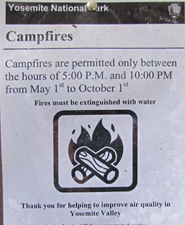 Some places have regulations about what months of the year or time of day fires are allowed.
Some places have regulations about what months of the year or time of day fires are allowed.
A campfire is a fun part of recreation, but not a toy for kids. Little ones should not poke around in the fire as they can too easily hurt themselves.
When roasting marshmallows, if one starts to burn and you don’t want that flavor, either give it to someone who does or let it finish burning in the fire. Do not try to put out the flames by waving it in the air as you can cause flying bits of burning sugar to land on others.
A long wire (that you thoroughly cleaned the end of before you put the hot dog on it), such as an untwisted uncoated coathanger is safer for roasting food than a short twig.
Again, newspaper, lightly crumpled, is a good starter for small twigs/tinder for a campfire. Pine needles mostly smolder and smoke.
The National Park Service has this advice:
“You want to think about safety before starting a fire and you should keep it in mind while the fire is going, too.
Close enough to toast marshmallows, not hands
Depending on the size of your fire and how windy it is, you might be able to sit right by it – or you might have to stand several feet away. Remember that synthetic clothing melts when it gets hot – don’t ruin your nice new fleece jacket by letting sparks blow on it from your campfire! If you plan on cooking on the fire, make sure you have cooking tools that are long enough so you have a safe distance between you and the fire. Look for cooking tools with insulated handles to avoid burns.
Watch children and pets around campfires
It almost goes without saying, but if you’re camping with kids or pets, keep an eye on them. Young children who haven’t been around a campfire before might not be cautious about running near it.
Drinking and burning
If the campground where you’re staying allows alcoholic beverages, do not throw bottles or cans into the fire! Broken glass and half-melted aluminum will probably make the next camper pretty unhappy. Burning anything but wood (especially plastics) can also lead to toxic gases.
Also keep in mind that your campground is a public space, and public intoxication is generally illegal, in addition to being pretty unsafe when you’re tending to an open fire.”
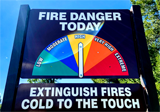
When it’s time to put out your campfire, Yosemite campground regulations say it needs to be put out with water, because a fire that’s just left to burn out or buried in dirt will smolder and pollute the air.
“Fires must be extinguished with water so that coals are cold and no smoke is visible.”
But, if you just pour a bunch of water on a blazing campfire, you’ll create a cloud of steamy smoke with a bunch of ash particles that may coat others nearby in your group or bother people two campsites away.
Instead, plan to take the time to put the fire out properly. Don’t put on extra wood really near bedtime. When it’s time to put it out, push the logs or remaining chunks of glowing charcoal apart, let them die down a little, and then finally sprinkle water on. If it makes huge clouds of steamy smoke, you need to let it die down before you put on more water.
To be sure it’s out completely, move any lanterns away from the area, turn off any flashlights (electric torches), stir the campfire debris around, then pour more water on any glowing coal bits. Don’t let anybody dissuade you because they say they won’t be able to build a fire the next day (they’re wrong). If you visit a place like Yosemite valley often enough, you will notice the smog and be glad you didn’t contribute to it.
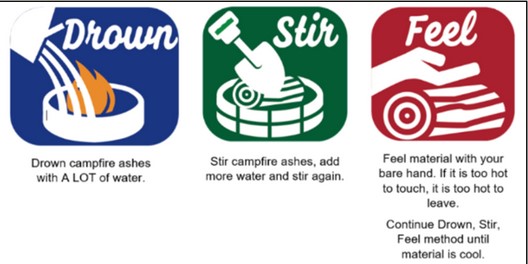
From the National Park Service Morning Report of August 08, 2003
Grand Teton National Park (WY)
Structural Fire at Colter Bay
David Aland, his wife, and two teenage daughters were staying at the concession-owned Colter Bay Tent Cabins on the night of July 15th. Although area temperatures had been unseasonably high, Aland decided to light a fire in the tent’s potbellied stove before the family went to bed at 11:30 p.m. After several unsuccessful attempts to light the fire with wood and paper, Aland removed a lid on the top of the stove and poured Coleman fuel into the opening. The smoldering fire immediately burst into flames and quickly spread to the tent walls and ceiling. The family evacuated the burning structure and the North District Fire Brigade was summoned. Nearby campers assisted by dousing the fire with extinguishers; fire brigade members put out the fire and conducted the investigation. Fortunately, Aland suffered only minor injuries, but the family clothing, camping gear and bicycles were destroyed. The tent-cabin is constructed of a combination of log and canvas walls with a canvas roof. The canvas was treated with a flame resistant coating that ensured the complete structure did not ignite and burn, but significant damage was incurred.
[Submitted by Bill Holda, Acting Chief Ranger]
See more about Colter Bay tent cabins.
The potato chips won a fire starters experiment in competition against dryer lint, dryer lint with candle wax drips (which did quite well), Fritos (which did not do at all well), Cheetos and two flavors of Doritos:

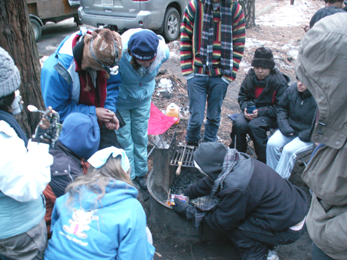
Here is an example of:
“Fire Restrictions in Place
Yosemite National Park is experiencing high fire danger, along with continued hot and dry weather patterns. Due to current and predicted fire conditions and fire behavior, the Superintendent of Yosemite National Park implemented Stage 1 Fire Restrictions until further notice.
By order of the Superintendent Yosemite National Park and under authority of Title 36, Code of Federal Regulations, Section 2.13(c):
You may not build, maintain, attend to or use a campfire or cooking fire (including charcoal fires) within Yosemite National Park, except in designated areas below 6,000 feet in elevation. Portable stoves using pressurized gas, liquid fuel, or propane are permitted, as are alcohol stoves (with and without a shutoff valve) including alcohol tablet/cube stoves. “Sierra” (twig) stoves are not permitted.
No smoking below 6,000 feet, except within an enclosed vehicle, a campground or picnic area where wood and charcoal fires are allowed or in a designated smoking area. All public buildings, public areas of concession buildings (including restrooms), other areas as posted and within 25 feet of any non-single family residential building remain closed to smoking at all times.
Campfires and cooking fires may still be used in designated campgrounds, picnic areas and residential areas in developed portions of the park in accordance with park regulations.
Designated Campgrounds and Picnic Areas: Upper Pines, Lower Pines, North Pines, Yellow Pines, Camp 4, Wawona, Bridalveil Creek, Hodgdon Meadow, Crane Flat, Tamarack Flat, White Wolf, Yosemite Creek, Porcupine Flat, Tuolumne Meadows, Lembert Dome, Tenaya Lake, Glacier Point, Cascade, El Capitan, Cathedral Beach, Sentinel Beach, Swinging Bridge, Church Bowl, and Lower Yosemite Falls.
There are no administrative exemptions to this order. This designation will remain in place until rescinded.
Fire restrictions reduce the probability of an accidental fire that could threaten visitors and employees during times of high fire danger. Cooperation in complying with these temporary restrictions is greatly appreciated.”
In all National Parks and many other places:
The author of this webpage, (written for my students), does not give any warranty, expressed or implied, nor assume any legal liability or responsibility for the accuracy, completeness, or usefulness of any information, product, or process included in this website or at websites linked to or from it. Users of information from this website assume all liability arising from such use.
